How to Crochet: Tunisian Entrelac (Part 1)
By Candace – 12 CommentsEntrelac is a knit and crochet technique that involves working with interconnected blocks that are worked on the diagonal. One method for executing this involves using tunisian crochet. To be able to do this technique, you need to be familiar with Tunisian crochet, including the starting row and Tunisian Simple Stitch (TSS) as well as decreasing on the forward pass and finishing off.
Note: This technique starts off with a long chain. If you are not using a pattern, here are some tips to determine its length. Entrelac squares usually have the same number of rows as they do stitches, but from the second row on, you will be picking up stitches from the starting chain. For each block, you will chain twice the width (in stitches) minus one. Simply multiply that number of chains by the number of blocks, and remember to add one turning chain.
If you like algebra, using x for block width (in stitches) and y for number of blocks, your starting chain will be (2x-1)y+1 stitches long.
For this tutorial, my starting rows will have 4 blocks that are 4 stitches wide, and I start by chaining 29.
Left-handed crocheters can hover over the pictures for another view.
First Block
Start with a Tunisian forward pass: pull up a loop in 2nd ch from hook and in next 3 ch (5 loops on hook)
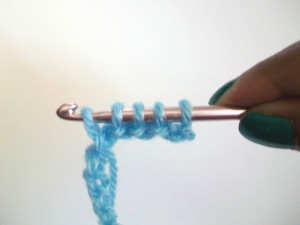
Now work the return pass– unlike with most Tunisian crochet, you do not start a return pass with a ch 1 in entrelac: (yo, pull through 2 loops) until only 1 loop remains on hook.
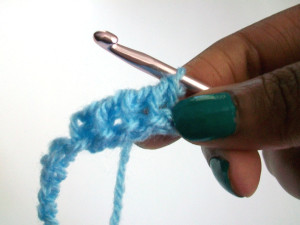
Forward Pass (rows 2-3): TSS in first 2 TSS, TSS2tog, pull up a loop in next ch of starting ch
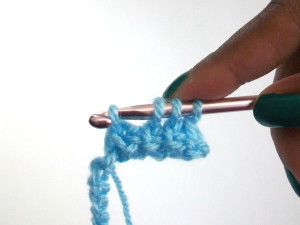
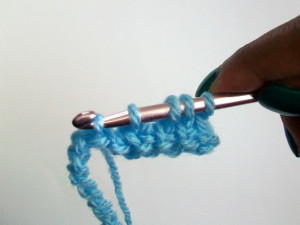
Return pass (rows 2-3): work as usual
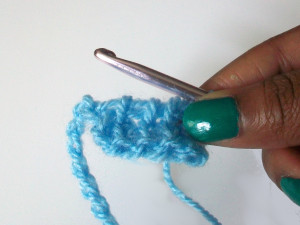
Last row of block: sl st in first 2 TSS as if to finish off, slst2tog, sl st in next ch of starting ch
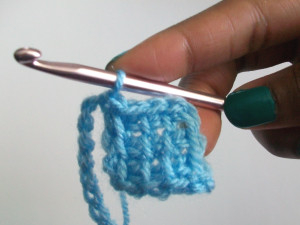
Blocks 2-4
Forward pass (Row 1): pull up a loop in next 4 ch of starting ch
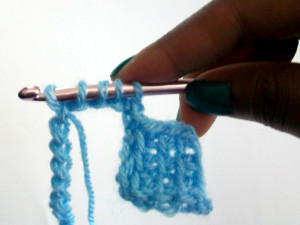
Return pass (all rows): work as usual
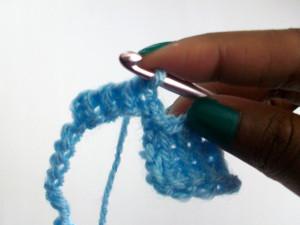
Forward pass (rows 2-3): TSS in first 2 TSS, TSS2tog, pull up a loop in next ch of starting ch. Then work return pass.
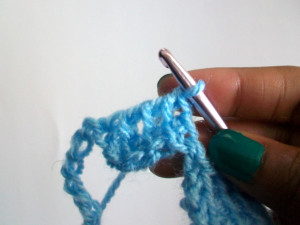
Last row of block: sl st in first 2 TSS, sl st2tog, sl st in next ch of starting ch. Then work return pass.
Repeat these steps to the end of the row of blocks
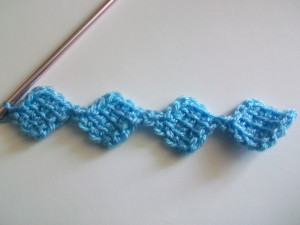
Now the first row of Tunisian entrelac blocks is done. Click here for a tutorial on the next rows!
If you need any help with this technique, just leave a comment below!


I’ve done the pattern Around the World but this line method loses me. I’m glad you’re doing this tutorial.
Thanks!
I love the effect of this stitch but want to know how to make the triangular half squares for a straight edge.
I want to make this with single crochet stiches
I love this tutorial. I want a bigger size if the square. I cannot figure it out. Any help would be greatly appreciated.
Hi, Carol.
How big of a square are you going for?
I am making a large Afghan so I was thinking maybe four inches. Or what size would you recommend for a large Afghan
It looks like the Round The World pattern you’re using actually uses a different technique, so the Tunisian instructions and formula aren’t going to help much. Since I’m not familiar with the pattern, I suggest following the designer’s instructions until you get a feel for it before you adjust things. It’s what I usually do.
If all you need is to know how many stitches should go in a square, try a gauge swatch and go from there.
My present WIP is a blanket with large squares. I’m using a 6mm afghan hook chaining 12 and working 10 rows, bind off and continue as usual. The pattern is as in Round the World but can be done as a rectangle beginning with two large squares.
Thank you. I was clueless. Around the world is the one I’m going to make my first time with this. Yikes lol
When you begin to see results you’ll keep going and going. Good luck with it! You can do it!
Hello, good to see someone managing to make tutorials on this 🙂 (I am more of the can’t even get pictures on to my PC)
I have made a vest now in this technique, also wrist-warmers made round (I do not like using a nedle and stitch to much, makes my projects come to an halt. My problem is now how to make arms for my vest to make it into a jacket. Do you have any idea how to increase the number squares in a way that will make good looking “tubes” for my arms?
Reguards
Interesting…I’m going to give this try using sugar and creme kitchen cotton to make a placemat.